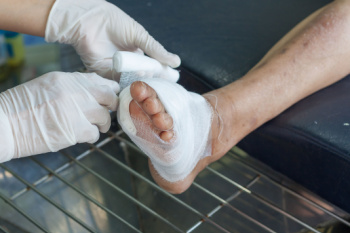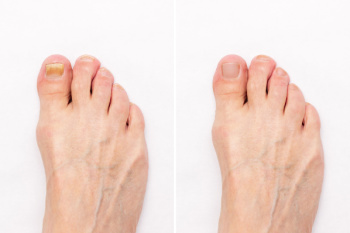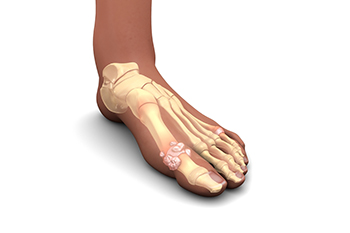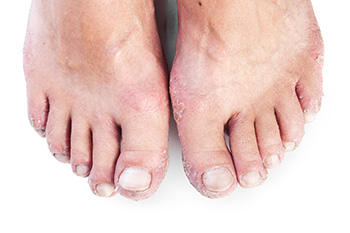Items filtered by date: June 2025
Foot Problems Related to Diabetes

Diabetic patients often experience foot problems due to nerve damage and reduced blood flow. High blood sugar over time can affect the nerves, leading to diabetic neuropathy, which makes it harder to feel pain, heat, or injuries in the feet. Small cuts, sores, or blisters may go unnoticed and untreated. Poor circulation, known as peripheral vascular disease, also affects people with diabetes and can slow healing, making the feet more prone to infections. Other diabetic foot problems include fungal infections like athlete's foot and thickened or discolored toenails. Dry or cracked skin, calluses, corns, and foot ulcers may develop. Deformities such as bunions and hammertoes, along with issues like blisters and ingrown toenails, may also occur. A chiropodist can assess circulation, check for nerve damage, and help manage foot conditions with regular care. Chiropodists are also trained to remove thickened skin, treat nail issues, and provide guidance on footwear to reduce pressure and friction. If you have diabetes and are experiencing foot problems, it is suggested that you are under the care of a chiropodist who can help you to manage this serious condition.
Diabetes can cause serious problems in the lower limbs if proper preventive measures are not taken and diabetic wound care is not performed. If you would like to learn more about caring for diabetic feet, please consult with Cynthia Chan, B.Sc., D.Ch from Healthy Advantage Foot & Orthotic Clinic. Our practitioner can help you maintain the health of your lower limbs and your mobility.
Diabetes can lead to a host of foot and ankle complications, including:
- Poor circulation
- Peripheral neuropathy
- Diabetic foot wounds and ulcers
- Infection
- Corns and calluses
- Dry, cracked skin
- Nail disorders
- Hammertoes
- Bunions
- Charcot foot
If you have diabetes, you must be vigilant of any changes in your foot health. This is best done through daily foot inspections. Using a mirror to help you if necessary, look for any:
- Cuts, scrapes, sores, or wounds
- Bruising or discoloration
- Swelling
- Rash
- Foul odor
- Nail changes
- Hair loss
- Warmth and inflammation
- Deformities
- Lower limb pain
- Strange sensations (numbness, tingling, burning, pins, and needles)
If you have any questions please feel free to contact our office located in Scarborough, ON .
Possible Causes of Toenail Loss

Toenail loss can happen for several reasons and is often painful. Injuries from stubbing the toe or dropping something on it are common causes. Fungal infections may also damage the nail and make it loosen, over time. Runners are at risk of toenail loss caused by repeated impact against the inside of the shoe, especially during long distances or downhill strides. Some people may develop a bony growth under the nail, called a subungual exostosis, which puts pressure on the nail until it detaches. Illness, certain medications, or poor circulation may also cause nail loss. Once the toenail falls off, it will not grow back in the same spot. A new nail must grow, which can take several months to a year. If part of the nail is still attached, do not pull it off. That can lead to infection or injury. A chiropodist can examine the toe, remove a damaged nail safely, and guide proper regrowth. If your toenail falls off, it is suggested that you schedule an appointment with a chiropodist for advice.
Toe pain is common and can have a variety of causes. Causes can range from a broken toe to an ingrown toenail. Many types of toe pain can be corrected, but any toe pain that inhibits your activities for an extended period should be discussed with a chiropodist. If you suffer from toe pain, please consult with Cynthia Chan, B.Sc., D.Ch from Healthy Advantage Foot & Orthotic Clinic. Our practitioner can help you maintain the health of your feet.
Common Causes of Toe Pain
- Trauma or fracture
- Cuts, sores, or bruises
- Rheumatoid arthritis
- Gout
- Turf Toe
- Morton’s neuroma
- Blisters
- Corns
- Bunions
- Hammertoes
- Ingrown toenails
- Plantar warts
- Athlete’s Foot
Symptoms of Toe Pain
- Toe deformity
- Burning
- Numbness
- Toenail deformity
- Wart or ulcer
- Swelling
- Redness
When to See a Chiropodist
- Bleeding or severe swelling
- Trauma, such as a broken bone
- Discoloration or extreme swelling
- Inability to bear weight
- Persistent pain
- Wounds that won’t heal
Diagnosis of Toe Pain
A chiropodist can conduct a thorough examination of the painful toe or toes in order to determine the best course of treatment. The exam may include assessing the tenderness of the area, taking an X-ray or other diagnostic test, or assessing your gait and range of motion. A discussion of what led to the advanced pain issue may follow. Included will likely be a health history, as well as a list of medications you are taking and other previous injuries you may have sustained.
Treatment for Toe Pain
With such a wide range of possible causes for toe pain, treatment can be varied in scope and length. Sometimes, the chiropodist will recommend lifestyle and activity changes. In cases of trauma or other injuries, X-rays or imaging tests will likely be used to determine the severity of the problem, particularly if any bones have been broken. Treatment may also include injections of pain-relief medication or anti-inflammatory drugs. Certain injuries will require the splinting, bracing, or wrapping of injured toes. Orthotics or special shoes may be prescribed in cases of bone deformities and gait issues. Removal of warts, calluses, and corns may be needed. In other cases, such as with patients who have diabetes or rheumatoid arthritis, ongoing treatment may be required to avoid more serious problems.
If you have any questions please feel free to contact our office located in Scarborough, ON .
Risk Factors for Gout

Gout is a painful form of inflammatory arthritis that often begins in the feet, especially the big toe. Several factors can increase the likelihood of developing gout. A diet rich in red meat, shellfish, and sugary beverages contributes to elevated uric acid levels, a key trigger for gout. Being overweight places additional stress on joints and also interferes with the body's ability to eliminate uric acid. Genetics play a significant role, as some individuals inherit a tendency to produce or retain excess uric acid. If you have a family history of gout or notice recurring foot pain, especially at night, it is strongly suggested that you consult a chiropodist who can help you to manage this painful condition.
Gout is a painful form of arthritis that can affect anyone. Please consult with Cynthia Chan, B.Sc., D.Ch from Healthy Advantage Foot & Orthotic Clinic. Our practitioner will assess your condition and provide you with quality foot and ankle treatment.
What Is Gout?
Gout is characterized by sudden, severe attacks of pain, redness, and tenderness in the joints. This type of arthritis is caused by a buildup of uric acid in the bloodstream. When uric acid crystallizes in a joint, often the joint of the big toe, it can bring about a gout attack.
Symptoms
Symptoms of gout include:
- Sudden and severe pain
- Swelling
- Redness
- Warmth
- Joint stiffness
- Joint deformity
Diagnosis
A chiropodist will ask questions about your personal and family medical history, followed by an examination of the affected joint. Laboratory tests and x-rays are sometimes ordered to determine if the inflammation is caused by something other than gout. A sample of fluid taken from your joint can show whether it contains uric acid.
Treatment
Prescription medications or injections are used to treat the pain, swelling, and inflammation. Patients with chronic gout can also use behavioral modifications such as diet, exercise, and decreased intake of alcohol to help minimize the frequency of gout attacks. Foods and beverages that are high in purines should be avoided since purines are converted in the body to uric acid. If left untreated, this painful condition can leave your joint permanently damaged and swollen.
If you have any questions please feel free to contact our office located in Scarborough, ON .
Plantar Warts Can Be Treated!
How Psoriasis Can Affect the Feet

Psoriasis can affect the feet by causing red, scaly, or cracked patches of skin that may become painful or itchy. In some cases, a condition termed palmoplantar pustular psoriasis can cause small pus-filled blisters on the soles. Unlike athlete’s foot, which is caused by a fungus and is contagious, psoriasis is an autoimmune condition that does not spread between people. However, because both can look similar, especially between the toes or on the soles, a proper diagnosis by a chiropodist is important. Psoriasis on the feet may be triggered by stress, skin injuries, weather changes, or certain medications. Nail changes and joint stiffness can also occur. Although there is no cure, treatment includes topical medications, light therapy, or oral medication for more severe cases. Managing foot psoriasis may take time and can require a number of treatment approaches. If you have symptoms of foot psoriasis, it is suggested that you schedule an appointment with a chiropodist for expert advice.
Systemic diseases are medical problems that affect the entire body. Many systemic diseases can bring about foot and ankle problems. If you have a systemic disease that affects your lower limbs, please consult with Cynthia Chan, B.Sc., D.Ch from Healthy Advantage Foot & Orthotic Clinic. Our practitioner can help you maintain the health of your lower limbs and your mobility.
Which systemic diseases can affect the feet?
- Peripheral artery disease - Causes inadequate blood flow to the lower limbs
- Peripheral neuropathy - Nerve damage in the nerves that supply the feet and ankles
- Diabetes - Can cause nerve damage, poor circulation, and a weakened immune system that can lead to the formation of poorly healing wounds on the feet
- Arthritis - A disease of the joints that damages joint lining, it often affects the small joints of the feet and the ankle joints
- Gout - A build up of uric acid in the bloodstream that forms crystals that can lodge in the joints
How can a chiropodist help?
Chiropodists help people who have systemic disease manage and maintain their foot health in a variety of ways. They can diagnose a multitude of foot and ankle problems, screen for certain systemic conditions, teach patients about proper foot care, and provide information about preventive strategies that patients could employ to avoid complications from their systemic diseases. Chiropodists can also treat foot and ankle problems through medications, foot and ankle exercises, orthotics, and lifestyle recommendations, among many other potential treatments
If you are living with a systemic illness that impacts your foot health, please feel free to contact our office located in Scarborough, ON .
